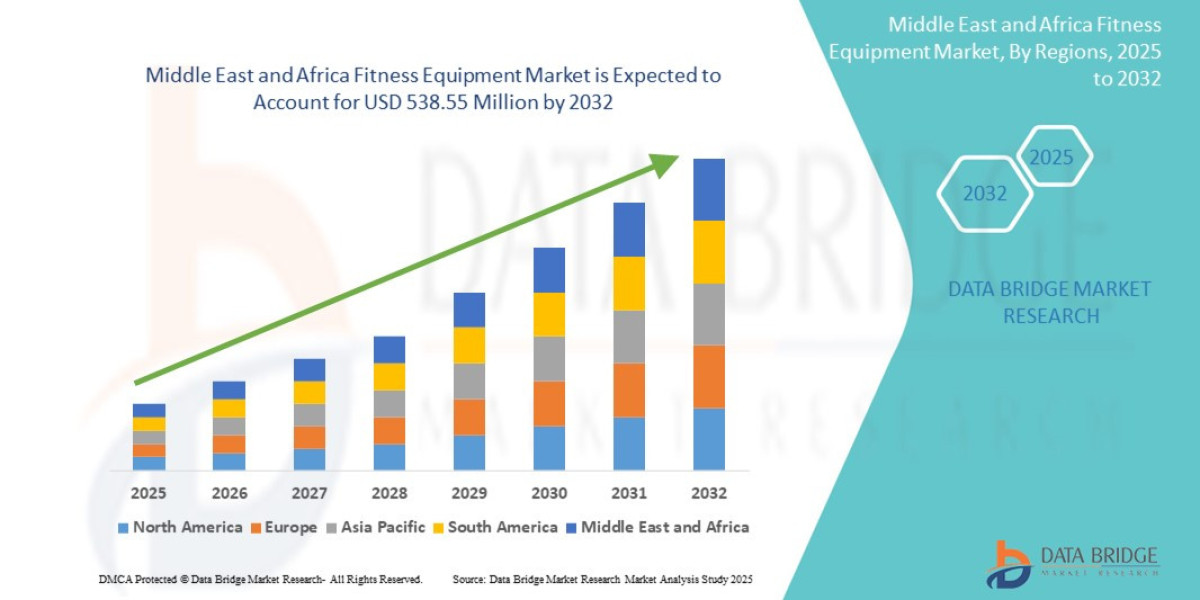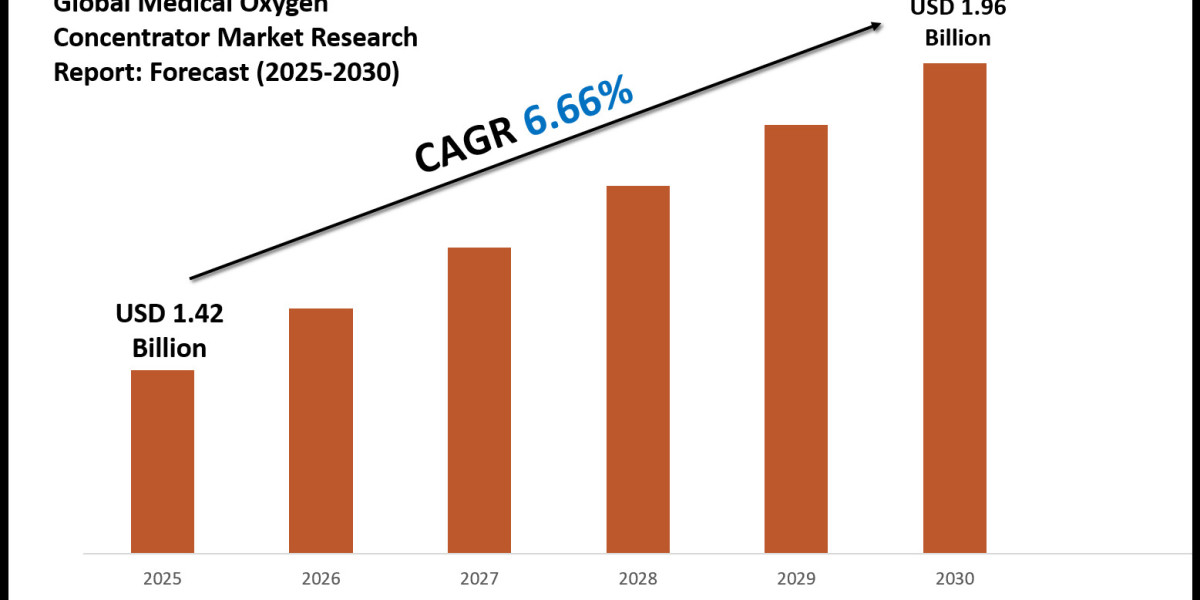"Executive Summary Middle East and Africa Fitness Equipment Market Research: Share and Size Intelligence
CAGR Value
- The Middle East and Africa fitness equipment market size was valued at USD 375.81 million in 2024 and is expected to reach USD 538.55 million by 2032, at a CAGR of 4.60% during the forecast period
- The market growth is largely driven by increasing health awareness, urbanization, and the expansion of fitness centers and gym chains across major cities in the region, fueling demand for both cardio and strength training equipment
- Moreover, government-led wellness initiatives, rising disposable incomes, and a growing youth population seeking active lifestyles are reinforcing fitness equipment adoption. These dynamics are accelerating market penetration and contributing significantly to the industry's sustained growth
Market research studies stated in this Middle East and Africa Fitness Equipment Marketreport are very thoughtful for the businesses which assist them with the better decision making and develop better strategies about production, marketing, sales and promotion. This Middle East and Africa Fitness Equipment Market report brings together comprehensive industry analysis with exact estimates and forecasts that offers complete research solutions with maximum industry clarity. The report includes CAGR value fluctuations during the forecast period of 2018-2025 for the market. And to serve the clients best in the industry, a team of experts, skilled analysts, dynamic forecasters and knowledgeable researchers work meticulously while forming this report.
This Middle East and Africa Fitness Equipment Market report is an ultimate source of information about the industry, important facts and figures, expert opinions, and the latest developments across the globe. The report studies various inhibitors as well as motivators of the market in both quantitative and qualitative manner so that users can have perfect information. The base year for calculation in the Middle East and Africa Fitness Equipment Market report is considered as 2017 while the historic year is 2016 which will tell you how the Middle East and Africa Fitness Equipment Market is going to perform in the forecast years. The Middle East and Africa Fitness Equipment Market report introduces the basics of industry such as market definitions, classifications, applications and industry chain overview, after which it covers industry policies and plans, product specifications, manufacturing processes, cost structures and so on.
Find out what’s next for the Middle East and Africa Fitness Equipment Market with exclusive insights and opportunities. Download full report:
https://www.databridgemarketresearch.com/reports/middle-east-and-africa-fitness-equipment-market
Middle East and Africa Fitness Equipment Market Dynamics
Segments
- Product Type: The Middle East and Africa fitness equipment market can be segmented by product type into cardiovascular training equipment, strength training equipment, and other equipment. Cardiovascular training equipment includes treadmills, elliptical machines, exercise bikes, and rowing machines. Strength training equipment consists of free weights, weight machines, and multi-station equipment. Other equipment may include accessories such as fitness trackers, yoga mats, and foam rollers.
- End-User: The market can also be segmented by end-user into commercial and residential segments. Commercial end-users include gyms, fitness centers, and health clubs, while residential end-users encompass individuals who purchase fitness equipment for personal use at home.
- Distribution Channel: The distribution channel segment includes online retail stores and offline retail stores. Online retail stores offer the convenience of shopping from home and a wide range of products, while offline retail stores allow customers to physically examine the equipment before making a purchase.
Market Players
- Technogym: Technogym is a prominent player in the Middle East and Africa fitness equipment market, offering a range of high-quality cardio and strength training equipment for both commercial and residential use. The company is known for its innovative designs and advanced technology integration in its products.
- Life Fitness: Life Fitness is another key player in the market, specializing in cardio and strength training equipment for commercial facilities. The brand is recognized for its durable and user-friendly machines that cater to the needs of fitness enthusiasts and athletes.
- Johnson Health Tech: Johnson Health Tech is a global leader in the fitness equipment industry, providing a wide variety of products for both commercial and residential customers. The company's innovative designs and focus on customer satisfaction have helped establish its presence in the market.
- Precor: Precor is a well-known name in the fitness equipment market, offering premium-quality machines for cardio and strength training. The brand is popular for its cutting-edge technology and ergonomic designs that enhance the overall workout experience for users.
The Middle East and Africa fitness equipment market is a dynamic sector experiencing steady growth due to increasing health awareness and the rising trend of personal fitness among the population. With a diverse range of products and end-user segments, the market presents lucrative opportunities for both established players and new entrants looking to capitalize on the growing demand for fitness equipment in the region.
The Middle East and Africa fitness equipment market is poised for significant growth in the coming years as the region experiences a surge in health consciousness and a growing emphasis on personal fitness. One key trend that is driving market growth is the increasing adoption of technology-integrated fitness equipment. Consumers are increasingly seeking innovative solutions that offer interactive features, real-time workout tracking, and personalized training programs. This shift towards connected fitness equipment presents opportunities for market players to differentiate their offerings and cater to the evolving needs of tech-savvy consumers.
Additionally, the commercial segment of the market is witnessing robust growth, driven by the expansion of gyms, fitness centers, and health clubs across the region. The proliferation of wellness facilities in urban areas, coupled with the rising disposable income of consumers, is fueling the demand for high-quality fitness equipment in commercial settings. Market players catering to the commercial segment need to focus on providing durable, user-friendly, and customizable solutions that meet the requirements of fitness professionals and facility operators.
Moreover, the residential segment of the market is experiencing a paradigm shift as more individuals opt to create home gyms for convenient and personalized workout experiences. The demand for compact and space-efficient fitness equipment is on the rise, as consumers look for solutions that blend seamlessly with their home interiors. Market players targeting the residential segment can capitalize on this trend by offering a diverse range of products that cater to different workout preferences and space constraints.
Furthermore, the distribution channel landscape in the Middle East and Africa fitness equipment market is evolving with the growing popularity of online retail stores. E-commerce platforms provide consumers with a convenient shopping experience, competitive pricing, and a wide array of product options. To stay competitive in the market, companies need to strengthen their online presence, enhance their digital marketing strategies, and offer seamless purchasing and delivery processes to meet the changing preferences of online shoppers.
In conclusion, the Middle East and Africa fitness equipment market present promising opportunities for market players to innovate, diversify their product offerings, and meet the evolving needs of consumers in both commercial and residential segments. By leveraging technology, catering to changing distribution channel dynamics, and tapping into the growing health and fitness trends in the region, companies can position themselves for sustainable growth and success in this dynamic market landscape.The Middle East and Africa fitness equipment market is witnessing significant growth driven by several key factors. One of the main drivers of market expansion is the increasing health consciousness among the population in the region. As individuals become more aware of the importance of fitness and overall well-being, there is a growing demand for home fitness equipment as well as commercial gym facilities. This shift in consumer behavior is fueling the adoption of fitness equipment across various end-user segments.
Moreover, the trend towards personalized fitness experiences is influencing the market dynamics, with consumers looking for equipment that offers interactive features and real-time tracking capabilities. Technology integration in fitness equipment, such as fitness trackers and connected devices, is becoming increasingly popular as individuals seek more engaging and customized workout routines. This presents an opportunity for market players to differentiate their offerings and cater to the evolving preferences of tech-savvy consumers.
In addition to the rise in health awareness and technology integration, the market is also benefiting from the expansion of fitness facilities in urban areas. The commercial segment, which includes gyms, fitness centers, and health clubs, is witnessing robust growth as more establishments open up to cater to the increasing demand for fitness services. Market players focusing on the commercial segment need to address the need for high-quality, durable equipment that can withstand heavy usage in professional settings.
Furthermore, the distribution channel landscape is evolving, with online retail stores gaining popularity among consumers in the Middle East and Africa. E-commerce platforms offer convenience, a wide selection of products, and competitive pricing, making them an attractive option for fitness equipment purchases. Companies need to adapt to this changing retail environment by enhancing their online presence, optimizing their digital marketing strategies, and ensuring a seamless shopping experience for customers.
Overall, the Middle East and Africa fitness equipment market present lucrative opportunities for market players to innovate, diversify their product offerings, and cater to the growing demand for fitness solutions. By aligning with consumer preferences for personalized experiences, embracing technology advancements, and adapting to the evolving distribution channels, companies can position themselves for success in this dynamic and rapidly expanding market.
Track the company’s evolving market share
https://www.databridgemarketresearch.com/reports/middle-east-and-africa-fitness-equipment-market/companies
Master List of Market Research Questions – Middle East and Africa Fitness Equipment Market Focus
- What is the scope of the global Middle East and Africa Fitness Equipment Market?
- What is the anticipated pace of growth for the Middle East and Africa Fitness Equipment Market sector?
- What Middle East and Africa Fitness Equipment Market segments are most profitable?
- Who are the powerhouses in the global Middle East and Africa Fitness Equipment Market?
- What are the top-performing countries in the dataset for the Middle East and Africa Fitness Equipment Market?
- What firms are ranked highest in revenue in Middle East and Africa Fitness Equipment Market?
Browse More Reports:
North America Diabetic Assays Market
About Data Bridge Market Research:
An absolute way to forecast what the future holds is to comprehend the trend today!
Data Bridge Market Research set forth itself as an unconventional and neoteric market research and consulting firm with an unparalleled level of resilience and integrated approaches. We are determined to unearth the best market opportunities and foster efficient information for your business to thrive in the market. Data Bridge endeavors to provide appropriate solutions to the complex business challenges and initiates an effortless decision-making process. Data Bridge is an aftermath of sheer wisdom and experience which was formulated and framed in the year 2015 in Pune.
Contact Us:
Data Bridge Market Research
US: +1 614 591 3140
UK: +44 845 154 9652
APAC : +653 1251 975
Email:- corporatesales@databridgemarketresearch.com
"






